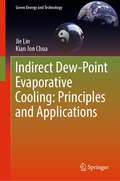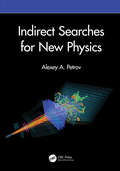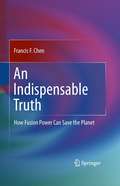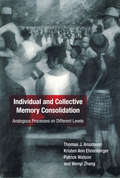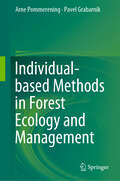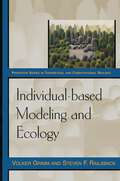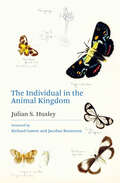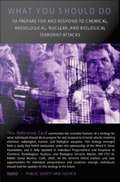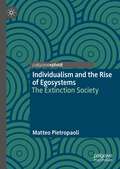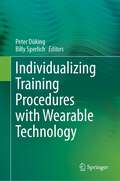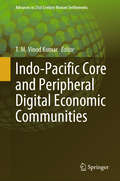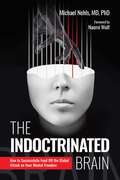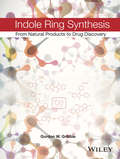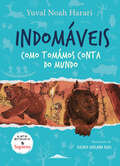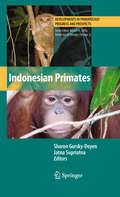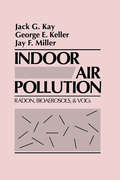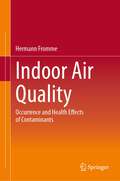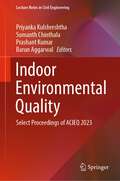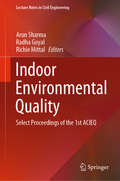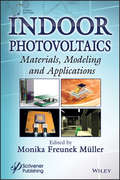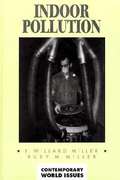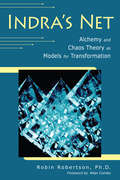- Table View
- List View
Indirect Dew-Point Evaporative Cooling: Principles and Applications (Green Energy and Technology)
by Jie Lin Kian Jon ChuaThis book systematically discusses state-of-the-art dew-point evaporative cooling and provides key insights into current research efforts and future research interests. Novel energy-efficient and environment-friendly cooling technologies are essential to reduce the sharply rising energy consumption and greenhouse gas emissions and achieve carbon neutrality. Conventional air-conditioners which adopt a vapor compression cycle are neither energy-efficient nor sustainable due to the use of compressors and chemical refrigerants, as well as their intrinsic coupling of sensible and latent cooling loads. With the merits of high energy efficiency and the ability to decouple cooling loads without using chemical refrigerants, indirect dew-point evaporative cooling provides an ideal alternative solution to air conditioning in a variety of applications. A comprehensive review of evaporative cooling and their underlying engineering challenges is included. Advanced engineering and modeling experience critical to the development of dew-point evaporative coolers are highlighted. The effective analysis techniques for dew-point evaporative coolers are documented, and their intrinsic characteristics captured by these methods are reported. Lastly, advanced dew-point evaporative cooling systems in various energy-connected applications are discussed by providing multiple case studies. Specifically targeted at HVAC engineers, thermal scientists, and energy-engineering researchers, this book will balance fundamental concepts, industrial applications, and leading-edge research. As this book provides readers with depth and breadth of coverage, it can also be used by graduate-level students in relevant fields.
Indirect Searches for New Physics
by Alexey A. PetrovThis is the first book to discuss the search for new physics in charged leptons, neutrons, and quarks in one coherent volume. The area of indirect searches for new physics is highly topical; though no new physics particles have yet been observed directly at the Large Hadron Collider at CERN, the methods described in this book will provide researchers with the necessary tools to keep searching for new physics.It describes the lines of research that attempt to identify quantum effects of new physics particles in low-energy experiments, in addition to detailing the mathematical basis and theoretical and phenomenological methods involved in the searches, whilst making a clear distinction between model-dependent and model-independent methods employed to make predictions. This book will be a valuable guide for graduate students and early-career researchers in particle and high energy physics who wish to learn about the techniques used in modern predictions of new physics effects at low energies, whilst also serving as a reference for researchers at other levels. Key features:• Takes an accessible, pedagogical approach suitable for graduate students and those seeking an overview of this new and fast-growing field• Illustrates common theoretical trends seen in different subfields of particle physics• Valuable both for researchers in the phenomenology of elementary particles and for experimentalists
An Indispensable Truth: How Fusion Power Can Save the Planet
by Francis F. ChenRecent books have raised the public consciousness about the dangers of global warming and climate change. This book is intended to convey the message that there is a solution. The solution is the rapid development of hydrogen fusion energy. This energy source is inexhaustible and, although achieving fusion energy is difficult, the progress made in the past two decades has been remarkable. The physics issues are now understood well enough that serious engineering can begin.The book starts with a summary of climate change and energy sources, trying to give a concise, clear, impartial picture of the facts, separate from conjecture and sensationalism. Controlled fusion -- the difficult problems and ingenious solutions -- is then explained using many new concepts.The bottom line -- what has yet to be done, how long it will take, and how much it will cost -- may surprise you. Francis F. Chen's career in plasma has extended over five decades. His textbook Introduction to Plasma Physics has been used worldwide continuously since 1974. He is the only physicist who has published significantly in both experiment and theory and on both magnetic fusion and laser fusion. As an outdoorsman and runner, he is deeply concerned about the environment. Currently he enjoys bird photography and is a member of the Audubon Society.
Individual and Collective Memory Consolidation: Analogous Processes on Different Levels (The\mit Press Ser.)
by Thomas J. Anastasio Kristen Ann Ehrenberger Patrick Watson Wenyi ZhangAn argument that individuals and collectives form memories by analogous processes and a case study of collective retrograde amnesia.We form individual memories by a process known as consolidation: the conversion of immediate and fleeting bits of information into a stable and accessible representation of facts and events. These memories provide a version of the past that helps us navigate the present and is critical to individual identity. In this book, Thomas Anastasio, Kristen Ann Ehrenberger, Patrick Watson, and Wenyi Zhang propose that social groups form collective memories by analogous processes. Using facts and insights from neuroscience, psychology, anthropology, and history, they describe a single process of consolidation with analogous—not merely comparable—manifestations on any level, whether brain, family, or society. They propose a three-in-one model of memory consolidation, composed of a buffer, a relator, and a generalizer, all within the consolidating entity, that can explain memory consolidation phenomena on individual and collective levels.When consolidation is disrupted by traumatic injury to a brain structure known as the hippocampus, memories in the process of being consolidated are lost. In individuals, this is known as retrograde amnesia. The authors hypothesize a "social hippocampus" and argue that disruption at the collective level can result in collective retrograde amnesia. They offer the Chinese Cultural Revolution (1966–1976) as an example of trauma to the social hippocampus and present evidence for the loss of recent collective memory in mainland Chinese populations that experienced the Cultural Revolution.
Individual-based Methods in Forest Ecology and Management
by Arne Pommerening Pavel GrabarnikModel-driven individual-based forest ecology and individual-based methods in forest management are of increasing importance in many parts of the world. For the first time this book integrates three main fields of forest ecology and management, i.e. tree/plant interactions, biometry of plant growth and human behaviour in forests. Individual-based forest ecology and management is an interdisciplinary research field with a focus on how the individual behaviour of plants contributes to the formation of spatial patterns that evolve through time. Key to this research is a strict bottom-up approach where the shaping and characteristics of plant communities are mostly the result of interactions between plants and between plants and humans. This book unites important methods of individual-based forest ecology and management from point process statistics, individual-based modelling, plant growth science and behavioural statistics. For ease of access, better understanding and transparency the methods are accompanied by R code and worked examples.
Individual-based Modeling and Ecology (Princeton Series in Theoretical and Computational Biology #2)
by Volker Grimm Steven F. RailsbackIndividual-based models are an exciting and widely used new tool for ecology. These computational models allow scientists to explore the mechanisms through which population and ecosystem ecology arises from how individuals interact with each other and their environment. This book provides the first in-depth treatment of individual-based modeling and its use to develop theoretical understanding of how ecological systems work, an approach the authors call "individual-based ecology.? Grimm and Railsback start with a general primer on modeling: how to design models that are as simple as possible while still allowing specific problems to be solved, and how to move efficiently through a cycle of pattern-oriented model design, implementation, and analysis. Next, they address the problems of theory and conceptual framework for individual-based ecology: What is "theory"? That is, how do we develop reusable models of how system dynamics arise from characteristics of individuals? What conceptual framework do we use when the classical differential equation framework no longer applies? An extensive review illustrates the ecological problems that have been addressed with individual-based models. The authors then identify how the mechanics of building and using individual-based models differ from those of traditional science, and provide guidance on formulating, programming, and analyzing models. This book will be helpful to ecologists interested in modeling, and to other scientists interested in agent-based modeling.
The Individual in the Animal Kingdom (Barnes And Noble Digital Library)
by Julian S. HuxleyThe groundbreaking first book by a major evolutionary biologist, published in 1912, that anticipated current thinking about organismal complexity.Julian Huxley&’s The Individual in the Animal Kingdom, published in 1912, is a concise and groundbreaking work that is almost entirely unknown today. In it, Huxley analyzes the evolutionary advances in life&’s organizational complexity, anticipating many of today&’s ideas about changes in individuality. Huxley&’s overarching system of concepts and his coherent logical principles were so far ahead of their time that they remain valid to this day. In part, this is because his explicitly Darwinian approach carefully distinguished between the integrated form and function of hierarchies within organisms and loosely defined, nonorganismal ecological communities. In The Individual in the Animal Kingdom, we meet a youthful Huxley who uses his commanding knowledge of natural history to develop a nonreductionist account of life&’s complexity that aligns with seminal early insights by Darwin, Wallace, Weismann, and Wheeler. As volume editors Richard Gawne and Jacobus Boomsma point out, this work disappeared into oblivion despite its relevance for contemporary research on organismal complexity and major evolutionary transitions. This MIT Press edition gives Huxley&’s book a second hearing, offering readers a unique vantage point on the discoveries of evolutionary biology past and present.
Individual Preparedness and Response to Chemical, Radiological, Nuclear, and Biological Terrorist Attacks
by Tom Latourrette Lynn E. DavisThe guide focuses on simple steps individuals can take to prepare for and respond to terrorist attacks with chemical, biological, radiological ("dirty bomb") and nuclear weapons. The guides contain both preparatory steps and specific response guidance. This includes what individuals will experience, what their goals should be, and what they should do during each type of attack
Individualism and the Rise of Egosystems: The Extinction Society
by Matteo PietropaoliThis book is a socio-philosophical journey across several aspects of our society’s focus on individual freedom, taking cues from some of the most prominent thinkers of our time. The auhtor posits that the human quest for freedom (mostly dominated by the Western culture but by no means confined to the West) has reached its ultimate paradox of making contemporary humans fundamentally unable to act as ecosystems (thus cooperate and collaborate). They have become egosystems, completely centred on the attainment of their own individual satisfaction. The author sees this as the culmination of a rightful quest for self-affirmation, which has been a key driver of progress across human history and by no means a negative one. But the paradox is that such a human-centred notion of freedom and individual accomplishment results in a much reduced ability to operate in sync with others, at the time when mankind would need more cooperation, collaboration and selflessness to address the key challenges it faces (from climate change to inequalities). Through the examination of the broad and interdisciplinary themes typical of social philosophy and the most recent cultural studies, in direct confrontation with the thought of authors such as Lipovetsky and Bauman, Lasch and Beck, Ehrenberg and Han, this book examines shifts in cultural norms at the possible end of a millenary civilization.
Individualizing Training Procedures with Wearable Technology
by Peter Düking Billy SperlichThis book gives evidence-based background information and advice to athletes and coaches on if and how data from wearable technologies can be applied for preparing individual training procedures to achieve improvement on aspects of performance and health.Sports practitioners frequently make decisions on long-term training planning and daily choices on different aspects of training, recovery and therapeutic procedures. Such decisions are essential to gain optimal performance enhancement, reduce likelihood of injuries and to reach peak performance. These decisions are complexed by the fact that there is no "blue-print" training procedure applicable to all athletes, and individual characteristics need to be considered to improve training procedures. With rapid technological advancements, data from Wearable Technologies is becoming increasingly available and potentially can aid athletes and coaches to individualize and optimize training procedures. Finally, the book explores if and how data can deliver actionable insights to inform long-term and day-to-day decision making to individualize training procedure.
The Indo-European Controversy
by Pereltsvaig, Asya and Lewis, Martin W. Asya Pereltsvaig Martin W. LewisOver the past decade, a group of prolific and innovative evolutionary biologists has sought to reinvent historical linguistics through the use of phylogenetic and phylogeographical analysis, treating cognates like genes and conceptualizing the spread of languages in terms of the diffusion of viruses. Using these techniques, researchers claim to have located the origin of the Indo-European language family in Neolithic Anatolia, challenging the near-consensus view that it emerged in the grasslands north of the Black Sea thousands of years later. But despite its widespread celebration in the global media, this new approach fails to withstand scrutiny. As languages do not evolve like biological species and do not spread like viruses, the model produces incoherent results, contradicted by the empirical record at every turn. This book asserts that the origin and spread of languages must be examined primarily through the time-tested techniques of linguistic analysis, rather than those of evolutionary biology.
Indo-Pacific Core and Peripheral Digital Economic Communities (Advances in 21st Century Human Settlements)
by T. M. Vinod KumarThis book demonstrates to the world by a series of replicable case studies, how the Indo-Pacific developmental initiatives of QUAD, France, Germany, the Netherlands, Canada, the European Union, Japan, Australia, and others can be implemented using the design of “Core Digital Economic Communities” within the 21 megacities that form Indo pacific megacity system and outside with independent country strategies to engage with these megacity systems where “Peripheral Digital Economic Communities” are located.
The Indoctrinated Brain: How to Successfully Fend Off the Global Attack on Your Mental Freedom
by Michael NehlsGlobal War on the Human Brain Throughout the world, mental capacity is declining, especially among young people, while depression rates are rising dramatically. Meanwhile, one in forty men and women suffers from Alzheimer's, and the age of onset is falling rapidly. But the causes are not being eliminated, quite the opposite. Can this just be coincidence? The Indoctrinated Brain introduces a largely unknown, powerful neurobiological mechanism whose externally induced dysfunction underlies these catastrophic developments. Michael Nehls, medical doctor and internationally renowned molecular geneticist, lays out a shattering chain of circumstantial evidence indicating that behind these numerous negative influences lies a targeted, masterfully executed attack on our individuality. He points out how the raging wars against viruses, about climate change, or over national borders are—more likely intended than not—fundamentally providing the platform for such an offensive against the human brain that is steadily changing our being and is aimed at depriving us of our ability to think for ourselves. But it is not too late. By exposing these brain-damaging processes and describing countermeasures that anyone can take, Nehls brings light and hope to this fateful chapter in human history. Nothing less will be decided than the question of whether our species can retain its humanity and its creative power or whether it will lose them irretrievably.
Indole Ring Synthesis: From Natural Products to Drug Discovery
by Gordon W. GribbleOf the myriad of heterocycles known to man, the indole ring stands foremost for its remarkably versatile chemistry, its enormous range of biological activities, and its ubiquity in the terrestrial and marine environments. The indole ring continues to be discovered in natural products and to be employed in man-made pharmaceuticals and other materials. Given the enormous resurgence in indole ring synthesis over the past decade -- highlighted by the power of transition metal catalysis -- this authoritative guide addresses the need for a comprehensive presentation of the myriad of methods for constructing the indole ring, from the ancient to the modern, and from the obscure to the well-known. Following presentation of the classic indole ring syntheses and many newer methods, coverage continues with indole ring syntheses via pyrroles, indolines, oxindoles, isatins, radical and photochemical reactions, aryne cycloadditions. This extensive volume concludes with the modern transition metal-catalyzed indole ring syntheses that utilize copper, palladium, rhodium, gold, ruthenium, platinum, and other metals to fashion the indole ring Indole Ring Synthesis is a comprehensive, authoritative and up-to-date guide to the synthesis of this important heterocycle for organic chemists, pharmaceutical researchers and those interested in the chemistry of natural products.
Indomáveis 1: Como Tomámos Conta do Mundo
by Yuval Noah HarariSabias que tens um superpoder? Queres saber qual? Este livro conta-te tudo! Como é que o fogo influenciou a evolução dos nossos estômagos? Sim, leste bem. Estômagos! O que é que o futebol nos diz sobre ser humano? Porque é que o dinheiro é o conto de fadas mais bem-sucedido de sempre? E o que é que isso tudo tem que ver com o facto de sermos a espécie dominante na Terra? Nesta primeira fantástica aventura da série Indomáveis, Yuval Noah Harari revela-te os segredos das origens da humanidade, como nunca antes te contaram. Como tomámos conta do mundo? A resposta está numa das histórias mais fascinantes que alguma vez irás ler!
Indonesian Primates
by Jatna Supriatna Sharon Gursky-DoyenIndonesia possesses the second largest primate population in the world, with over 33 different primate species. Although Brazil possesses more primate species, Indonesia outranks it in terms of its diversity of primates, ranging from prosimians (slow lorises and tarsiers), to a multitude of Old World Monkey species (macaques, langurs, proboscis moneys) to lesser apes (siamangs, gibbons) and great apes (orangutans). The primates of Indonesia are distributed throughout the archipelago. Partly in response to the number of primates distributed throughout the Indonesian archipelago, Indonesia is classified as the home of two biodiversity hotspots (Wallacea and Sundaland). In order to be classified as a hotspot, an area must have a large proportion of endemic species coupled with a high degree of threat including having lost more than 70% of its original habitat. Two areas within Indonesia meet these criteria. The tremendous diversity of primates in Indonesia, in conjunction with the conservation issues facing the primates of this region, created a need for this volume.
Indonesia's Rain Forests: Using Earth's Resources
by Moana AshleyRain forest ecology and conservation of natural resources for children.
Indoor Air Pollution: Radon, Bioaerosols, and VOCs
by Jack G. Kay George E. Keller Jay F. MillerIndoor Air Pollution: Radon, Bioaerosols, and VOCs covers the most current aspects of indoor pollution research, including vitally important topics such as radon, bioaerosols, and volatile organic compounds. The book presents information on microbial contamination abatement, chemical characterization of air samples, sick building syndrome, biological pollutants, liability of indoor air pollution, and measurement and control of radon. Industrial hygienists, toxicologists, safety officers, and engineers in industry and academia should consider this book a "must read" selection.
Indoor Air Quality: Occurrence and Health Effects of Contaminants
by Hermann FrommeThis book presents a comprehensive and detailed overview of indoor pollution, covering the main contaminants in the indoor environment – air and dust, the health aspects of exposure, and different possibilities for a risk assessment. The book outlines the chemical substances and physical and biological factors that occur more frequently indoors, which are of health significance, or for which only limited information on their occurrence indoors is available to date. It also provides guidance to identify where problems may arise in the future and where data is missing for a valid exposure and risk assessment as well as for consequent risk management. Written by a highly recognized and experienced medical expert in the field, the book starts with an introduction to the indoor environment, including topics such as indoor environmental quality and health, indoor climate, sampling of indoor pollutants, and measures to improve indoor air quality. The author then delves into the fundamentals of exposure assessment and special exposure indoor situations, followed by in-depth coverage of the health aspects, and indoor air occurrence of several substances such as volatile organic compounds, very volatile organic compounds, semi-volatile organic compounds, and particulate matters and fibers. Particular attention is given to bioaerosols like mold, microbial volatile organic compounds, mycotoxins, and viruses. Readers will also find chapters devoted to the main health aspects and indoor occurrence of inorganic gases, radon and metals, and smoking. The book closes with a chapter on risk assessment, in which readers will learn more about the basics of risk assessment, key points and processes of a health evaluation, and guidance for assessing indoor air contamination. This book is a unique compilation of the current worldwide exposure situation in private and public indoor spaces, and an important reference for researchers that are willing to assess the rising burden of disease and potential causes behind degraded indoor air quality. Scientists, students, and policymakers interested in the fields of medicine and environmental sciences will understand the appeal of this book.
Indoor Environmental Quality: Select Proceedings of ACIEQ 2023 (Lecture Notes in Civil Engineering #380)
by Priyanka Kulshreshtha Sumanth Chinthala Prashant Kumar Barun AggarwalThis book presents select proceedings of the 2nd Asian Conference on Indoor Environmental Quality (ACIEQ-2023) and explores the current research in the field of indoor environmental quality which includes indoor air quality, adaptive thermal comfort, productivity and health, indoor lighting, and acoustics. These themes include exposure assessment in various microenvironments, i.e., commercial, residential, and institutional and its effect on human health and performance for better well-being. The book also discusses the strategies to improve thermal and visual comfort along with filtration technologies for improving indoor air quality in urban built environment. It also emphasizes on profiling of indoor air pollutants such as bioaerosols, volatile organic compounds, particulate matter in schools, offices, dyeing/printing industry, and modes of commute. The book is a valuable reference for researchers and professionals in engineering, architecture, lighting, and acoustic areas interested in the relevant aspects of indoor environmental quality.
Indoor Environmental Quality: Select Proceedings of the 1st ACIEQ (Lecture Notes in Civil Engineering #60)
by Arun Sharma Radha Goyal Richie MittalThis volume presents selected papers presented during the First Asian Conference on Indoor Environmental Quality (ACIEQ). The contents cover themes of indoor air quality monitoring and modeling; the influence of confounding factors like thermal comfort parameters, such as temperature and relative humidity with respect to different building types, e.g., residential, commercial, institutional; ventilation characteristics, lighting and acoustics. It also focuses on people's performance, productivity, and behavior with respect to their exposure to various indoor air pollutants and parameters influencing the overall indoor environmental quality. This volume is primarily aimed at researchers working in environmental science and engineering, building architecture and design, HVAC and ventilation, public health, and epidemiology. The contents of this volume will also be useful to policy makers working on occupational health and building codes.
Indoor Photovoltaics: Materials, Modeling, and Applications
by Monika Freunek MüllerIndoor photovoltaics (IPV) is the most promising power source for indoor electronic devices, especially sensor devices and edge nodes for the Internet of Things, and it will gain considerable interest due to the development of the field. This field of photovoltaics differs to other fields due to irradiance and spectral distribution conditions as well as the (close to) energy autarkic field conditions. The book provides the engineer and researcher with guidelines, provides a comprehensive overview over theoretical models, efficiencies, application design, and first available products.
Indoor Pollution
by E. Willard Miller Ruby M. MillerThe presence of polluted air in the home from heating and cooking food is as old as civilization itself. In modern times the general public only became aware of the health hazards when the number of household chemicals increased dramatically in the twentieth century. Few governmental regulations have been passed to regulate the home environment. The concept that the home is a man's castle has delayed the passing of governmental regulations that control the quality of the indoor environment. Standards are, however, being established by many private organizations.
Indra's Net
by Allan Allan Robin RobertsonIn this clear, engaging book, Robin Robertson draws parallels between alchemy and chaos theory and shows how to apply them to our inner development. He is not proposing they replace traditional spiritual paths, but rather that they reflect deep structures in the psyche that any inner journey awakens. The model they provide necessarily underlies all paths of spiritual transformation and describes a framework for the stages through which any seeker goes. No matter what your particular calling, these insights enrich understanding of the transformative process, whether outside in the world, or within your life.
Indra's Net: Alchemy and Chaos Theory as Models for Transformation
by Robin Robertson"Somewhere in the celestial palace of the dancing god Indra, there hangs a fabulous net that spreads out boundlessly over the cosmos in every direction. The divine craftsman has so cleverly fashioned this net that at every knot there hangs a dazzling jewel, each one so brilliantly polished that it reflects all the others. As above, so below. . . . " This image of Indra's net from a Buddhist sutra symbolizes the mystery that, through our own transformation, each of us is united with everyone and everything else. Author Robin Robertson finds parallel models in ancient alchemy, which tried to change base metal into gold, and modern chaos theory, which posits that tiny initial changes can have huge and unexpected outcomes-as a butterfly in Brazil might cause a tornado in Texas. Robinson lucidly shows how these two systems reveal the pattern of inner development in any spiritual tradition. No matter what one's particular calling, these surprising insights can enrich and accelerate the transformative stages of any spiritual seeker. Book jacket.
